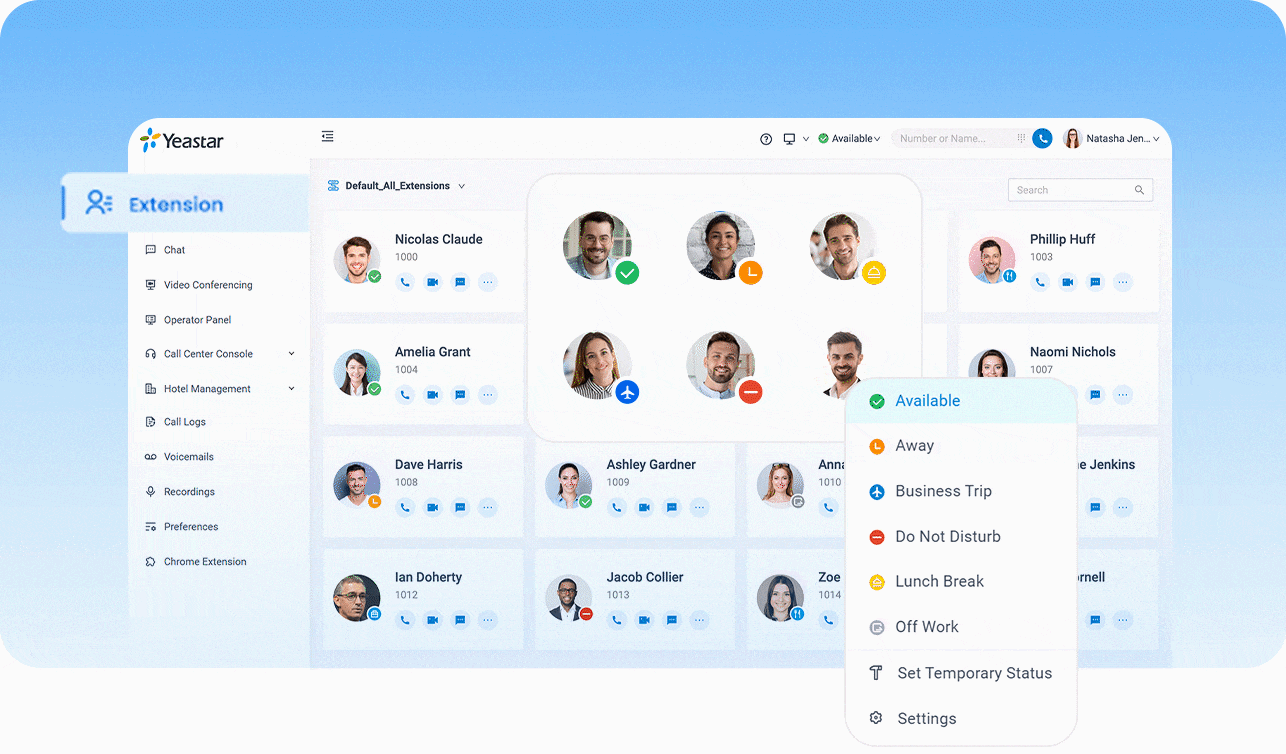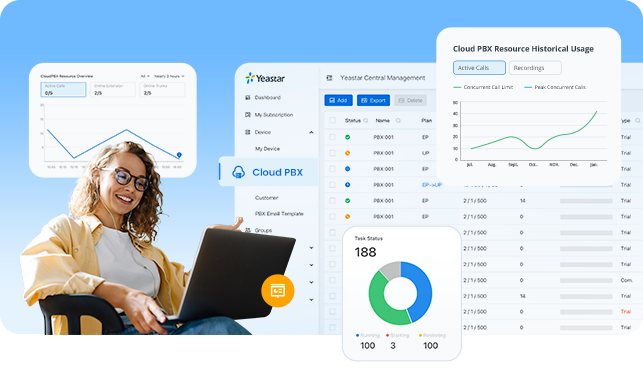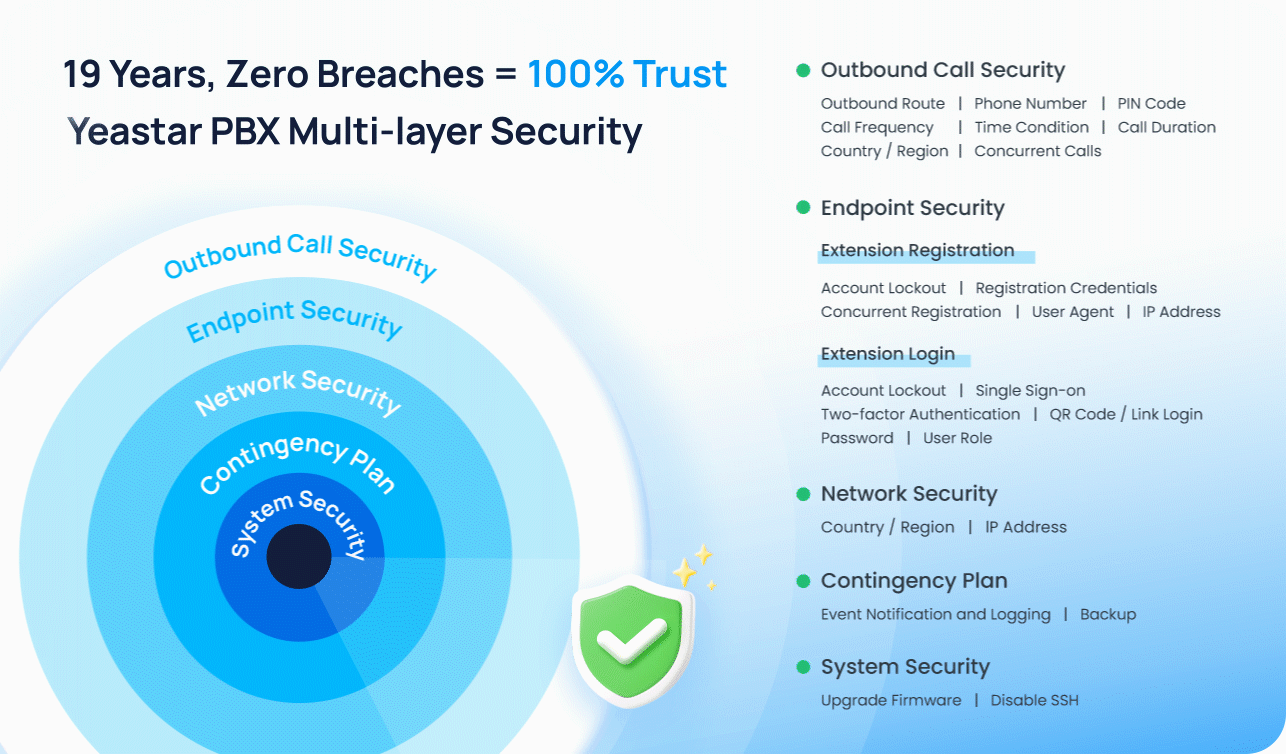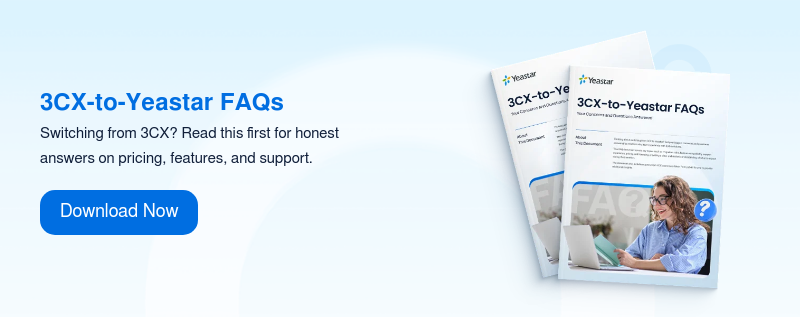
As businesses grow and remote work becomes standard, the way we manage communications is evolving. What once worked well—such as 3CX—may no longer meet the expectations of modern teams that require flexibility, security, scalability, and ease of management.
Whether you’re facing licensing frustrations, security concerns, or outgrowing 3CX’s architecture, now is the time to consider your options. This guide introduces six leading 3CX alternatives and explains why Yeastar stands out as the most future-ready choice for businesses of all sizes.
Jump to ↓
- What is 3CX?
- Why Consider a 3CX Alternative?
- How We Evaluated These 3CX Alternatives
- The 6 Best Alternatives to 3CX
- What makes Yeastar the Best 3CX Alternative?
- Experience the Most Advanced 3CX Alternative
- Common FAQs
What Is 3CX?
3CX is a VoIP-based phone system and UCaaS platform that can be self-hosted or deployed in the cloud. It gained traction for being budget-friendly and flexible, allowing companies to move away from legacy PBXs.
However, recent product decisions and architectural limitations—such as frequently changed pricing policies, forced reliance on SBCs for remote devices, and a 2023 security breach—have prompted many IT teams to search for a more robust 3CX alternative, straining trust and weakening partner relationships along the way.
Why Consider a 3CX Alternative?
Many teams today are evaluating 3CX alternatives due to increasing friction with the platform’s limitations. Key concerns include:
-
Security risks
The trojanized 3CX installer breach in 2023 shook trust across the industry, especially among compliance-driven sectors.
-
Shared tenancy instead of isolation
Despite being labeled “multi-tenant,” 3CX operates on a shared-instance architecture, which raises concerns around scalability, data isolation, and reliability.
-
No white-labeling
Resellers and service providers cannot customize 3CX products—restricting branding and user experience control.
-
Frequent license disruptions
3CX has changed its pricing and licensing structure multiple times, introducing uncertainty around future costs.
For teams already using 3CX, switching doesn’t have to be complicated. Discover more details about migration to Yeastar with minimal effort.
How We Evaluated These 3CX Alternatives
To help you identify the most suitable 3CX alternative, we compared dozens of platforms using five key criteria:
-
Features & Ease of Use
Every business phone system should provide the core features teams rely on—call routing, video conferencing, voicemail, call recording, mobile and desktop apps—delivered in a way that’s intuitive and manageable. A strong 3CX alternative should match or exceed 3CX in functionality, while reducing the time and complexity required to set things up.
We gave higher marks to platforms that offer visual interfaces, smart defaults, integrated tools like CRM connectors, and a more modern user experience. The best solutions don’t just replicate 3CX’s features—they streamline them to work better for today’s teams.
-
Security-first Architecture
We prioritized platforms with zero major breach history, end-to-end encryption (SRTP, TLS), support for 2FA, and built-in call control safeguards like country-based blocks and outbound rate limits.
-
Price for Value & Reliable Partnership
Platforms that combine meaningful functionality with predictable, scalable pricing stood out—especially when long-term value is enhanced through built-in features, simplified management, and flexible deployment options.
Whether you’re managing internal systems or client deployments, cost control is critical. Flexible licensing options (such as per-extension or concurrent call models), transparent upgrade paths, and partner-friendly margins all contributed to a platform’s score—especially where 3CX falls short due to version-based restrictions and shifting policies.
-
True Multi-Instance Architecture
Unlike 3CX’s shared-instance setup—which is more like user groups or departments than true multi-tenancy, a truly multi-instance platform gives each tenant a fully isolated PBX environment. This architecture ensures stronger data protection, better uptime performance, and simplified fault isolation across deployments.
We evaluated how easily a provider enables rebranding. For service providers, the ability to white-label interfaces, apps, and customer portals helps maintain brand consistency and create a more polished end-user experience—something 3CX lacks natively.
-
Seamless Migration Experience
A good 3CX alternative should offer an easy transition path. Vendors that support direct import of 3CX configuration files and provide migration wizards scored higher, as they reduce downtime, preserve configuration, and simplify onboarding.
The 6 Best Alternatives to 3CX
⭐ Yeastar — Best 3CX Alternative Overall
With a broader feature set and greater flexibility, Yeastar P-Series Phone System delivers a UC solution that meets the core needs of businesses currently using 3CX. It addresses key pain points such as steep pricing hikes, shifting license policies, limited support, and security concerns—offering a more stable and partner-friendly alternative.
For teams managing multiple deployments, Yeastar Central Management (YCM) serves as a powerful tool for bulk provisioning, monitoring, trunk and DID sharing, and system-wide updates—all from a single interface.
Branding is simple too: Yeastar supports full white-label customization, letting you add your own logo, theme, and app names across the entire platform.
Managing Yeastar is easy, even for non-technical users. Its Web Portal features an intuitive design, drag-and-drop call routing, and pre-integrated CRM connectors like Microsoft Dynanmic 365, Zoho, and HubSpot. The channel–only vendor is also known for its‘ partner–first strategy and fast & reliable technical support.

Pricing that fits your model: Yeastar offers both Simultaneous Call (SC) and Per Extension (Per Ext.) licensing options, giving businesses the flexibility to choose a model that matches their usage patterns. The pricing is reported 30%–70% less than 3CX, depending on the region. Minimum order quantities (MOQs) are lower, feature restrictions are fewer, and there are no forced version-based license jumps—just simple, scalable pricing.
🔹 Avaya® — A Traditional Enterprise UC Leader
Avaya offers a long-standing portfolio of on-prem and cloud PBX solutions, often favored by large corporations with complex telephony needs. However, its reliance on proprietary hardware and legacy architecture can lead to high deployment and maintenance costs.
While Avaya Cloud Office (delivered via RingCentral) is more modern, it still lacks the flexibility and multi-instance control that many IT teams now expect in a 3CX alternative. Scalability and integrations are decent, but pricing is complicated and channel tools are limited.
🔹 Mitel® — A Hybrid Powerhouse with On-Prem Focus
Mitel excels in supporting hybrid and on-premises environments, especially for verticals like hospitality and healthcare. Its MiVoice and MiCloud offerings are robust for traditional deployments with deep PBX customization.
That said, its licensing is rigid, setup can be time-consuming, and many UC features require separate products or third-party add-ons. For SMBs or service providers looking for a cloud-first 3CX alternative with simplified management, Mitel may feel too heavyweight and fragmented.
🔹 Zoom® — Best for Video-First Collaboration
Zoom Phone is a strong option for organizations already embedded in the Zoom ecosystem. It offers native PSTN connectivity, SMS, voicemail, and call queues integrated into the familiar Zoom interface.
However, Zoom’s voice offering is still maturing. Granular administrative controls, telephony-specific analytics, and multi-tenant management are limited compared to other 3CX alternatives. Additionally, licensing can become expensive as features are added beyond basic calling.
🔹 Vonage® — Great for Developers and API-Led Teams
Vonage Business Communications combines UC functionality with a strong CPaaS platform, making it attractive for developer-centric organizations looking to embed voice and messaging into their workflows.
That said, Vonage can become expensive quickly due to à la carte pricing and a reliance on proprietary or pre-approved hardware. Its UC interface is less intuitive than modern rivals, and white-label or multi-instance support is virtually nonexistent—making it less ideal as a 3CX alternative for resellers.
🔹 Nextiva® — All-in-One Simplicity for Small Businesses
Nextiva packages voice, video, chat, and CRM-lite features into a user-friendly interface, positioning itself as an “easy VoIP” choice for SMBs. Its onboarding process is simple and customer support is often praised.
However, Nextiva uses a per-user pricing model that scales poorly for growing teams. Core features like advanced analytics, integrations, and even SMS may require higher-tier plans or separate licenses. For teams seeking a more customizable, multi-tenant-ready 3CX alternative, Nextiva may not be flexible enough.
What makes Yeastar the Best 3CX Alternative?
Among all the 3CX alternatives we reviewed, Yeastar stands out as the most complete and forward-looking solution—not just for replacing a phone system, but for enabling easier service delivery, stronger control, and more scalable channel operations.
-
Flexible Pricing & Licensing Options
Yeastar supports both Simultaneous Call—with packages starting from just 4 SC, and Per Extension licensing. Costs is reduced by 30% when compared with 3CX, making Yeastar a budget-friendly and partner-friendly alternative.
-
Fully White-Label Ready
3CX lacks native branding capabilities, but Yeastar lets businesses and resellers customize logos, colors, names, login pages, and even desktop/mobile clients and central management portal. This creates a seamless experience for users and adds professional value for those managing deployments under their own brand.

-
Designed for Simplicity and Control
Yeastar’s P-Series PBX System features an intuitive web-based interface that makes system configuration accessible even to non-technical administrators. From drag-and-drop call routing to real-time monitoring, users can make changes quickly.
At the same time, administrators benefit from powerful features like call queue wallboards, built-in operator panels, and customizable ring strategies—all easily accessible through a clean, responsive dashboard.

-
Centralized Management at Scale
With Yeastar Central Management (YCM), managing multiple customer systems is no longer a challenge. YCM enables:
- Centralized visibility into all PBX resources
- Bulk configuration and batch upgrades
- Remote troubleshooting and diagnostics
- SIP Trunk sharing and DID number assignment
- Security alerts, backup automation, and role-based access control
More…

For organizations supporting multiple sites—or service providers managing dozens of clients—this drastically reduces operational overhead and enhances system reliability.
-
Security by Design
Yeastar employs end-to-end encryption (SRTP and TLS), outbound call rate limiting, IP-based access control, geo-restrictions, and two-factor authentication. The company has zero breach incidents across its 19-year history, and adheres to ISO 27001 security practices.

-
Driven by Real-World Feedback
Yeastar doesn’t just ship features—it co-develops them. Through monthly feedback cycles with customers and partners, Yeastar actively shapes its product roadmap. In the past year alone, it has delivered:
- Hotel Management Module
- Outbound Call Center with Auto Dialer
- CRM Template Integration (connect any CRM you prefer via API)
- Call Flow Designer (coming soon)
- AI-based features, including TTS, voicemail transcription, etc. (coming soon)
More…
This iterative, user-centered approach ensures that Yeastar evolves with the real needs of business operators—not based on arbitrary release schedules.
Experience the Most Advanced 3CX Alternative Today
If your current phone system is limiting your growth, creating security concerns, or making remote work harder than it needs to be—it may be time to move on.
With Yeastar, you get everything 3CX lacks: stronger PBX isolation, more powerful branding, centralized management, transparent pricing, and a team that actually listens. Whether you’re managing five users or five hundred, Yeastar gives you the tools to scale with confidence.
You can start a free trial to explore the platform hands-on, or contact us directly for a live demo with our solution engineers. No pressure, no commitment—just clarity on whether this is the right 3CX alternative for your business.




